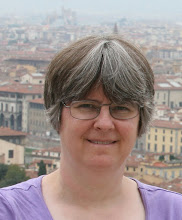Droplets detail
 OK, as promised, here's what I ended up doing with that photograph from yesterday. Using Photoshop, I rotated it 28 degrees counter-clockwise, cropped it in close, leaving the vein on the diagonal and a curved line of droplets for the eye to follow, and then played with the levels a bit to exaggerate the red-orange color. Let me know how you like this image as compared to the other one. Does the fact that it's not "natural" ruin it for you as a picture of beauty in the world?
OK, as promised, here's what I ended up doing with that photograph from yesterday. Using Photoshop, I rotated it 28 degrees counter-clockwise, cropped it in close, leaving the vein on the diagonal and a curved line of droplets for the eye to follow, and then played with the levels a bit to exaggerate the red-orange color. Let me know how you like this image as compared to the other one. Does the fact that it's not "natural" ruin it for you as a picture of beauty in the world?
The title of this blog, by the way, is taken from Don Postema's book Space for God: The Study and Practice of Prayer and Spirituality. I first discovered it in the library at Rivendell, a retreat center on Bowen Island, near Vancouver. I've since used it in teaching a class on prayer. Doing photography as an art form helps me to be more attentive to the world around me, and thus more aware of God's creation. I have to slow down necessarily in order to do this, and that makes space in my otherwise busy life for God to reveal himself to me.



2 comments:
Beautiful photo, again! At first, reading about how you manipulated the photo did sort of spoil it for me, as I felt as if I had been cheated into thinking that the color was "real." But then, of course, that made me ponder what's real and what's nature and what's art, and I wondered why touching it up on Photo Shop is any less artistic than arranging the leaf just so, or putting it on a certain background, or even than taking the photo in the first place! I still "feel" as if a photo should not be touched in order to "count" as "real" art, but as you can tell from the ridiculous proliferation of quotation marks, I'm questioning all those assumptions. Which is good.
And for personal use, I've long given over film & gone to the world of touch-ups. Why does that seem so different?
Good comments! Thanks.
I used to have hang-ups about that too, which is why I resisted going to digital photography for so long. But how different is touching up a photograph in Photoshop to choosing "unnatural" colors of paint to paint a scene in a surreal style? The camera and software are artists' tools just as much as the painter's brush and pigments are.
Art photography is more than just documentation. If it were only the latter, then of course one would prefer an untouched photograph. This has enormous implications for forensic photography. Can a photographic print even be admitted as evidence in court anymore, now that there are such amazing ways of manipulating them to say whatever you want?
Post a Comment